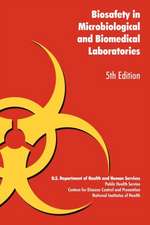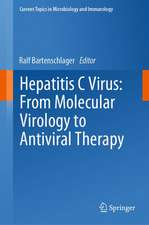Agents Transmissible from Simians to Man
Autor Manfred Bracken Limba Engleză Paperback – 17 noi 2011
Preț: 728.89 lei
Preț vechi: 767.26 lei
-5% Nou
Puncte Express: 1093
Preț estimativ în valută:
139.52€ • 151.60$ • 117.27£
139.52€ • 151.60$ • 117.27£
Carte tipărită la comandă
Livrare economică 21 aprilie-05 mai
Preluare comenzi: 021 569.72.76
Specificații
ISBN-13: 9783642719134
ISBN-10: 3642719139
Pagini: 472
Ilustrații: XIII, 454 p.
Dimensiuni: 170 x 244 x 25 mm
Greutate: 0.74 kg
Ediția:Softcover reprint of the original 1st ed. 1987
Editura: Springer Berlin, Heidelberg
Colecția Springer
Locul publicării:Berlin, Heidelberg, Germany
ISBN-10: 3642719139
Pagini: 472
Ilustrații: XIII, 454 p.
Dimensiuni: 170 x 244 x 25 mm
Greutate: 0.74 kg
Ediția:Softcover reprint of the original 1st ed. 1987
Editura: Springer Berlin, Heidelberg
Colecția Springer
Locul publicării:Berlin, Heidelberg, Germany
Public țintă
ResearchCuprins
1 Viruses.- 1.1 Herpesviridae.- 1.2 Poxviruses.- 1.3 RNA-Viruses.- 1.4 Rhabdoviruses.- 1.5 Picornaviruses.- 1.6 Reoviridae.- 1.7 Myxoviruses.- 1.8 Pseudomyxoviruses.- 1.9 Retroviruses.- 1.10 Hepatitis Viruses.- 1.11 Papovaviruses — SV40.- 2 Mollicutes.- 2.1 Mycoplasmataceae.- 2.2 Ureaplasmataceae.- 3 Bacteria.- 3.1 Spirochaetaceae.- 3.2 Spirillaceae.- 3.3 Pseudomonadaceae.- 3.4 Brucella Spp.- 3.5 Bordetella Sp.- 3.6 Enterobacteriaceae.- 3.7 Gram Negative Bacteria of Uncertain Affiliation.- 3.8 Bacteroides Spp.- 3.9 Micrococcaceae.- 3.10 Streptococci.- 3.11 Clostridium.- 3.12 Listeria Monocytogenes.- 3.13 Erysipelothrix Insidiosa (Rhusiophatiae).- 3.14 Corynebacteriaceae.- 3.15 Actinomycetales.- 3.16 Mycobacteriaceae — Tuberculosis Type.- 3.17 Mycobacterium Leprae.- 4 Fungi.- 4.1 Superficial Mycoses.- 4.2 Cutaneous Mycoses.- 4.3 Subcutaneous Mycoses.- 4.4 Systemic Mycoses.- 4.5 Histoplasmosis.- 4.6 Candidiasis.- 4.7 Coccidioides Immitis.- 4.8 Paracoccidioides Brasiliensis.- 4.9 Cryptococcus Neoformans.- 4.10 Geotrichum Candidum.- 5 Pneumocystis Carinii.- 6 Protozoa.- 6.1 Sarcodina.- 6.2 Ciliata.- 6.3 Zoomastigophora (Flagellata).- 6.4 Sporozoa.- 7 Nematodes.- 7.1 Strongylina.- 7.2 Rhabdisoidea.- 7.3 Oesophagostomidae.- 7.4 Trichostrongylids.- 7.5 Metastrongylidae.- 7.6 Oxyurids.- 7.7 Ascaridoidea.- 7.8 Spirurida.- 7.9 Filariina.- 7.10 Dracunculoidea.- 7.11 Aphasmidea.- 8 Trematodes.- 8.1 Dicrocoeliidae.- 8.2 Fasciolidae.- 8.3 Opisthorchiidae.- 8.4 Heterophyidae.- 8.5 Echinostomatidae.- 8.6 Paragonimidae.- 8.7 Schistosomatidae.- 8.8 Paramphistomidae.- 9 Cestodes.- 9.1 Intestinal Forms.- 9.2 Cestodes: Tissue Forms.- 9.3 Acanthocephala.- 10 Appendix.- 11 Subject Index.




